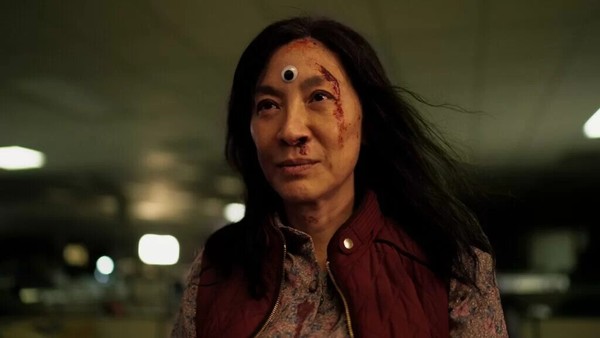Everything Everywhere All at Once, also known by its abbreviation EEAAO, was released in Korea on October 12. Like its name, the movie is a comprehensive delight gift-wrapped for all audiences, giving us all we could have ever wanted. It has hallmark characteristics of science fiction, comedy, East Asian cinema, and so much more. These seemingly non-compoundable traits come together in a cinematic amalgam under the hands of Daniel Kwan and Daniel Scheinert, a duo of film directors and screenwriters known as the “Daniels”.
Now familiar to the masses, the concept of multiverse was not one that was explored as deeply as concepts like time travel. It has come to light due to the international success of Marvel Studios and its series, but the cinematic exploration or exploitation of the multiverse was scanty at best. Of course, the usage of multiverse is only a starting point for the story to branch out; how well it has been reflected may not be of interest to most viewers. Yet I couldn’t not help but to marvel at the bold and flamboyant craftsmanship Daniels have shown. They dance around the concept freely, manipulating and molding the film according to their will.
First entering the world of EEAAO, the film tosses us into the world of Chinese immigrants. Instead of unrealistic battles that span the multiverse, Evelyn, the main character, seems to be facing crises that we are very familiar with — parent, spouse, and children issues as well as a tax audit. And all this goes on in a fast-paced crisscross of three languages: English, Chinese, and Cantonese. Evelyn uses Chinese with Waymond, English with Joy, then Cantonese with Gong Gong. But even amidst this disarray, the viewers can understand (thanks to the subtitles) that there is a storm brewing for them. Still, one could not initially spot the comedic brilliance of Daniels, which was so clearly visible in their direction of the film Swiss Army Man and the music video for “Turn Down for What”.

After the main plot and conflict of the movie has been revealed to us, the film goes through a tremendous change. Starting from the character of Alpha Waymond, the film delivers impeccable action sequences and nostalgia. Jobu Tupaki and her comical absurdities bring both laughs and narrative. Even when you don’t recognize the small parodies and cultural implications hidden here and there, the visual effects and camera movements are nothing short of innovative and captivating for the audience. Yet what was most captivating was the chaos, all the abrupt emergence in the movie.
In this movie, everything is everywhere. A pet pig shows up randomly, then in the next second you see a wrestler with plastic dildos. On a cinematic level, the audience shares the experiences of the multiverse with Evelyn — different world, different people, and different stories. While you are fundamentally captivated, you might ask: “Is this necessary?” Traditionally, films with multiverses only allowed narratives that “borrowed” from the multiverse, like Avengers: Endgame. The central story, character all still resided in the “main” universe. Daniels decided to make every multiverse its own stage, progressing the plot anywhere they saw fit with incredible artistry and finesse. What was remarkable was how they kept this chaos in check with a central narrative curve, a message penetrating the film. This contrast of confusion and clarity continues on to the end — then you realize there’s more to the film. As aforementioned, as conflicts unravel, you realize that this isn’t really about saving the world. It’s about family, and it’s about understanding and connecting. What Jobu Tupaki wanted wasn’t really the universe.
But at the same time, it is. A nihilistic view is clearly represented when Joy says, “If nothing matters, then all the pain and guilt you feel for making nothing of your life goes away.” The war of multiverses isn’t really the problem of the film. It is the permeating fear of the cosmic, self-doubt, and hatred — all the things we have sought answers for but could not — that really lie under the narrative. Contrary to expectations, it is Waymond who holds the key to the answers. While Evelyn, Joy, and everyone who seemed competent and almost super failed to find the answer, failed to be different, it is Waymond, a portrayal of a sweet, naïve beta male, who returns answers nobody expected. “The only thing I do know is that we have to be kind. Please, be kind.” With this, every single little detail from Act 1 — googly eyes, the cookies, the receipts and circles, the customers, the lighting — and just everything and everywhere gather all at once to give a finale for this gargantuan microcosm.

